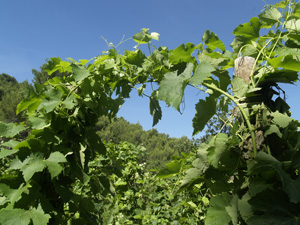
Wine News

Since March, we have welcomed groups of wine lovers to Domaine Chapelle in the picturesque Burgundy village of Santenay for the Discovery Experience Days. These hands-on Wine Experience Days aim to better understand the work of the winemaker in the vineyard to produce the best quality grapes for harvesting.
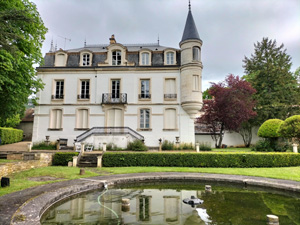
After the welcome and briefing of the day’s programme, Jean-François Chapelle recounted the history of his family, his winery, and of Burgundy wines.
We then set out into the vineyard to meet our adopted vines, whisper them a few sweet words, and take some photographs to immortalise the moment!
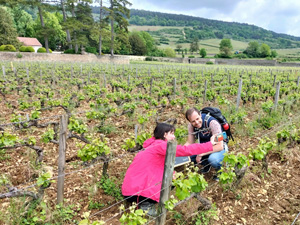
We were joined by Jean-François’ son, Simon, who has been managing the vines and vinification process since 2021. Jean-François is progressively taking his retirement and passing on the reigns to Simon.
Simon explained the whole vegetative life cycle from pruning through to the harvest, and we quickly learnt that the work carried out in the vineyard demands lots of manual effort.
Pruning is done between January and April, before the branches are arced and attached to the bottom training wire to delay the moment when the buds burst, with the aim of reducing the risk of being impacted by any frosts. The participants of the Discovery Experience days in March were able to witness the complexity of pruning!
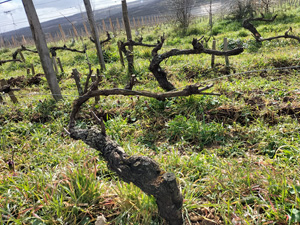
The buds burst in the second half of April, and the vines started to grow the fruit-bearing branches for this new season.
In May, the main job was de-budding the vines, which involves removing any double shoots and unwanted branches to limit the quantity of grapes that each vine can produce. It’s a job that demands dexterity and some thought, as the participants of the May Discovery Experience Day found out by de-budding some vines for themselves. There is always the fear of damaging the vines or choosing the wrong branch to remove, but it’s only by doing that you really learn.
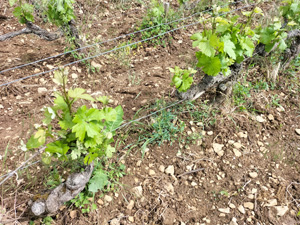
The branches grew rapidly in May, and so we had to return to each vineyard plot to raise the training wires twice, finishing by trimming the tops of the vines to stop the branches from becoming too intertwined. Raising the training wires was the task we were set for the Discovery Experience Days in June and July.
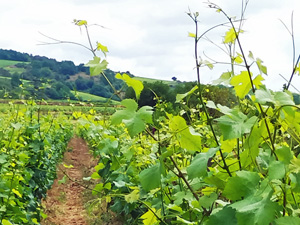
Domaine Chapelle has been adhering to the organic charter for 15 years now, working the soil mechanically and only using treatments permitted in organic agriculture. We spent quite a bit of time discussing how to work they work organically at the vineyard and the challenges of doing so.
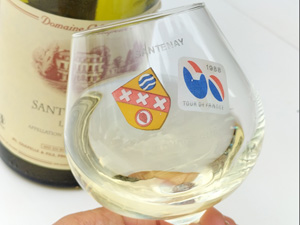
After these great mornings spent in the vineyard, we returned to the winery for a nice glass of fresh Santenay white wine, accompanied by the famous Burgundy gougères. We then sat down to lunch with three food and wine parings: the fish terrine starter served with a Burgundy Aligoté, the Gaston Gérard chicken main course paired with the Clos des Cornières Santenay red wine, and the chocolate and blackcurrant dessert accompanied by a Santenay Premier Cru.
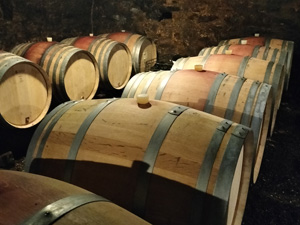
Depending on the weather, in the afternoon, we went for a walk through the vineyards to see the different terroir and/or we visited the cellar to have a glimpse of what we’ll cover in much more detail during the Vinification Experience Days next spring.
But the next rendez-vous is to meet up for the Harvest Experience Days in September to harvest the grapes from our vines!
In May and June, we visited Château de Jonquières, a magnificent family-run winery in the Terrasses du Larzac wine-growing region, to spend a couple of Discovery Experience Days with the winemakers, Charlotte and Clément de Béarn. The aim of these Wine Experience days is to learn about all the work that goes on in an organically certified vineyard.
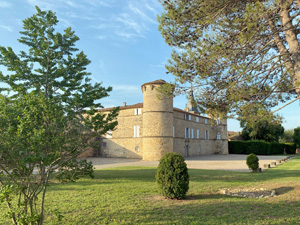
We were welcomed by Gaël, the Gourmet Odyssey wine specialist, and the winemakers who gave us an introduction to the château and its history that has been passed down through 32 generations.
The days were focused mainly on the work in the vineyard, but we had to be flexible in May to avoid the showers. Charlotte and Clément were all smiles to see the rain because the winter had been very dry and the vines were desperately in need of water. Clément assured us that there would be enough dry patches to be able to do some work in the vineyard, and he was right!
Once in the vineyard, Charlotte and Clément explained the work that had been done during the winter and early spring, most notably to prune the vines. In spring the vines need lots of care to keep them healthy, and accompany them in preparing them for an optimal harvest. The vines had already grown quickly, so there were two tasks awaiting our help.
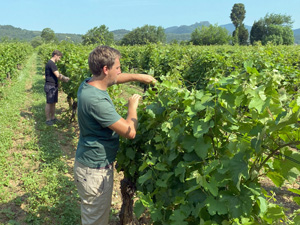
First we raised the training wires in a couple of rows of Cinsault to trap the branches between them. This helps the vines to support the weight of the grapes and foliage.
We also de-budded the vines by removing the young shoots that had sprouted from the vine trunks and might transport disease from the soil to the vines. We also removed any double-buds in a plot of Carignan, leaving the best branches to bask in the sun and to have a better airflow around them so that they dry more quickly, again reducing the risk of disease.
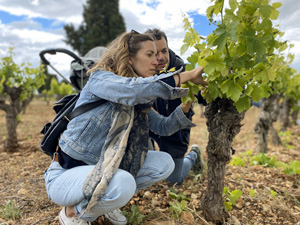
After the effort, we were rewarded back at the château with a well earned aperitif and winemakers lunch. Charlotte and Clément had selected 5 of their wines to accompany the delicious meal which had been prepared by a local chef, Aubin Vie.
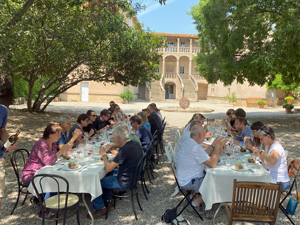
The meal is always a lovely moment when the participants get to ask lots of questions to the winemakers about their life, daily routine, and the differences between the wines that we were tasting.
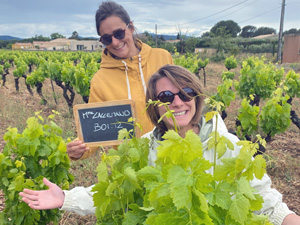
In the beginning of the afternoon, we went on a little stroll to visit our adopted vines. It’s a great spot, and the 70 odd year old Carignan vines that were planted by Charlotte’s grandmother are a sight to behold.
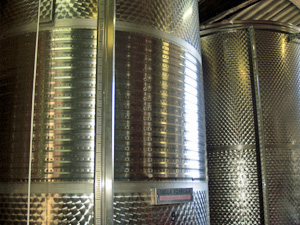
The days finished in the chai where Clement enlightened us a little to his universe and the tools he uses to receive the grapes at harvest time. We’ll see all of that in action when we return to the winery in September for the Harvest Experience Day!
Benoît, the Gouret Odyssey wine expert, introduced us to the day while we enjoyed a coffee and croissant. Then Matthieu, who represents the 13th generation of winemaker at the winery, presented Château Coutet and its diversity of terroirs and grape varietals. It’s an exceptional place where the vines, trees, and family have been living together in perfect harmony for over 400 years.
In the vinification hall, Matthieu explained the fermentation phases, something that those of us who had already participated in the Harvest Experience Day had touched upon last September. Matthieu proved to be someone both very knowledgeable and passionate about the subject.
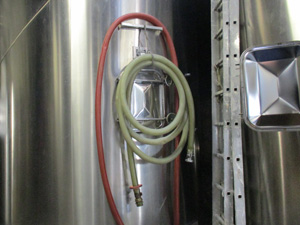
We then went through to the barrel room, where the wine is laid to rest and age in oak barrels once the fermentation has finished. Traditionally, wines are aged in oak barrels in Bordeaux. At Château Coutet, the aim is to limit the amount of wood that can be tasted in the wine, so the percentage of new barrels used is fairly low.
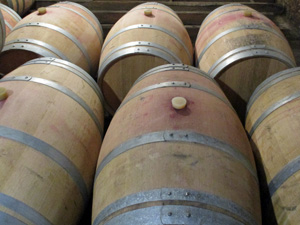
Back in the fermentation hall, Benoît then initiated us to the art of wine tasting, starting with a reminder of the basics, so that we were all talking the same wine language. We blind tasted a first series of wines, a very interesting exercise that enables us to better concentrate on the aromas and tastes to analyse the wines by avoiding being influenced by labels and any preconceived ideas that go with them.
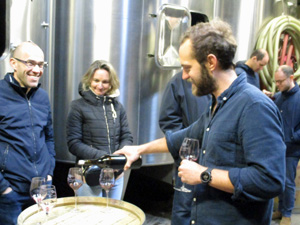
We continued with another blind tasting of the four grape varietals grown at the winery. This enabled us to identify the characteristics of each before having a go at blending them together in different proportions to create our own wines like real Saint-Emilion wine-makers!
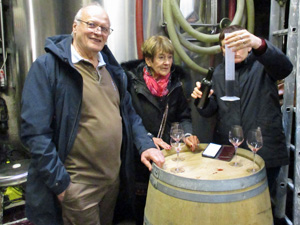
The morning flew by and before we knew it, it was time to sit down to lunch. We continued the wine tasting with the Vertige white wine made by a cousin of the family at Château Grand Verdus, which accompanied the Landais salad for the starter. The 2020 Château Coutet paired wonderfully with the beef brochette main course, ending with the magnificent 2018 Demoiselles wine, which has a long finish and complexity to it that matches the best of the Saint-Emilion wines.
After lunch, we made the most of the sun’s return to go and visit our adopted vines up on Saint-Emilion’s limestone plateau, surrounded by Château Coutet’s prestigious neighbours. We each found our vines thanks to a personalised slate that had been put out. We marvelled at the wonderful view, and took some photos in the hope of winning a magnum of wine in the “My Vine” photo competition.
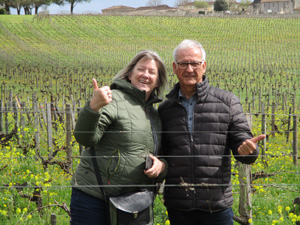
We finished the day with a visit to the cellar where the bottles are stored. Matthieu explained how the wine is bottled and labelled, the last remaining steps before the wine is ready to be sold and tasted.
Many thanks to Matthieu for his warm welcome, and to all the participants for this great day, that was as enjoyable as always.
The impact of global warming on winemaking in France
- Categories :
- Wine
- Wine News
- Wine Making
- Gourmet Odyssey
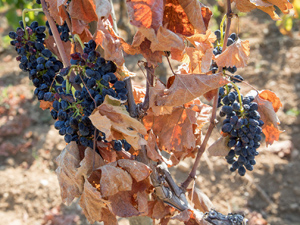
How is climate change impacting the vines?
What solutions are available to fight against climate change in the vineyard?
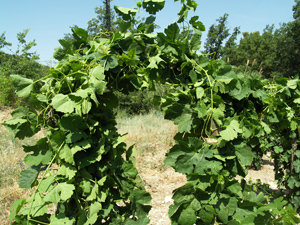
Regarding the frost, there are different methods available to protect the vines, but the most environmentally friendly way and simplest way is to delay the winter pruning. Traditionally, pruning started around December, depending on the region and size of the winery, but pruning is often now pushed back until March to delay the buds bursting and to protect the buds from the first frosts.
Some of these solutions might work today, but are they viable in the long term?
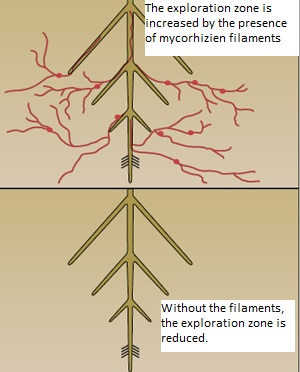
- Arinarnoa (origin INRA, 1956): Made from a hybrid of Tannat and Cabernet Sauvignon. Low sugar production, good acidity. Gives well structured, colourful, and tannic wines with complex and lasting aromas.
- Castets (origin south west France): An historic grape varietal, forgotten in Bordeaux. Resistant to grey rot, odium, and mildew. Allows to make colourful wines for keeping.
- Marselan (origin INRA, 1961): A hybrid between Cabernet Sauvignon and Grenache. A late developing varietal, resistant to grey rot, odium, and mites. Enables making colourful wines with character, of good quality and the potential for ageing.
- Touriga Nacional (origin Portugal): A very late developing varietal that is less at risk from spring frosts. Resistant to fungal diseases with the exception of dead arm wood disease. Makes very good quality wines that are complex, aromatic, full-bodied and good for ageing.
- Alvarinho (origin Iberian Peninsula): Marked aromatic characteristics that counterbalance the loss of aromas due to global warming. Resistant to grey rot. Medium sugar potential that enables the winemaker to produce subtle and aromatic wines with good acidity.
- Liliorila (origin INRA, 1957): Like the Alvarinho, it has good aromatic qualities giving powerful and scented wines.
What will happen if the climate situation doesn’t change in the next few years?
The increasing role of robots in organic vineyards
- Categories :
- Wine
- Wine News
- Gourmet Odyssey
- Château Coutet
The first robots appeared around 10 years ago, with notably the Vitirover, a grass cutting robot that was tested for the first time at our partner winery, Château Coutet in Saint-Emilion. We’ll be asking a few questions to Adrien and Matthieu David-Beaulieu, the son and nephew of the inventor of the robot, and winemakers at Château Coutet at the end of this article.
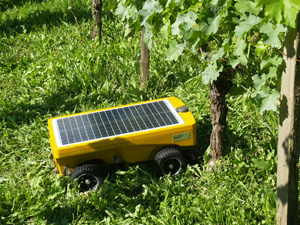
The main aim of robots is to reduce the workload of the winemakers. Finding the people to work in the vineyards is becoming more and more difficult, particularly in finding qualified tractor drivers. And the tractors aren’t always very suited to working in the vineyard as they can easily uproot the vines. The second factor that helped robots find their place was the questioning of the use of herbicides and other chemical products as opposed to more environmentally friendly alternatives.
The benefit of using robots that is most sought after by the winemakers is to increase their productivity. A winemaker’s year is very cyclical and is sometimes a real race against time. Of course, the robots have not yet reached a stage when they can replace the winemakers and thankfully so! They can be a welcome help in long and repetitive tasks like weeding, spraying, or working the soil. This new way of farming also helps attract a new type of worker, one that is younger and more interested in technology.
Even though the revolution is underway, there is still resistance from some winemakers. The main reason remains the social impact. Working with new technological tools calls for a change in working habits and lots of time before integrating them into the workflow. You also need to think of training, as using robots isn’t always innate and requires time spent learning how to use them. The effort needed to integrate the robot should not be overlooked because even if it is there to help lessen the workload, humans still remain central, and the robots can present some added risks, whether they be physical by cuts or flying debris, or mental by adding stress to the users. You need to learn to trust the machine which is not always an easy thing to do.
The second constraint is of course the cost of these robots, as you need to pay between 80 000 and 200 000 € to buy one. You then need to add annual maintenance costs as well as adding all the GPS coordinates for each vineyard plot, which can quickly add up.
It is important to note that the robots have certain limitations. They are only allowed to circulate on private property, and so can’t use the road or public paths between vineyard plots, creating an additional task of towing the robots from one plot to another. You also need to have a trained operator close by in case of emergency.
The robots are also reliant on the topography and weather. For example, robots such as the Vitirover, can’t be used on slopes greater than 15% or on ground that is too slippy.
A closer look at Vitirover
Xavier David-Beaulieu, grew up at Château Coutet in the family winery that has always been cultivated organically. He couldn’t understand why there were no solutions to reduce the use of glyphosates in the vineyards elsewhere. It is estimated that 8000 tonnes of glyphosate are used each year by professionals in France. It is both dangerous for the health because it is cancerogenic, and also for the environment because it destroys the biodiversity.
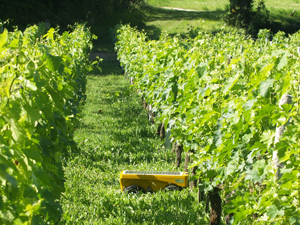
Xavier David-Beaulieu partnered with Arnaud de la Fouchardière to create Vitirover, the first grass cutting robot. It was designed to reply to the need of returning to farming techniques that were kinder on the environment by using new technologies.
The Vitorover is a small robot, 30 cm wide, weighing 20kg, and that is 100% autonomous thanks to its solar panels. It moves at 500 m / hour and can cut a hectare in 15 days. They are not designed to work alone, but in a flock with a shepherd that controls them remotely with a smartphone, and who can intervene if necessary.
The Vitirovers aren’t available for sale, the company instead offering a service contract to maintain the vineyards, so that the clients don’t need to upkeep the machines over the long term. Today Vitirover doesn’t just interest winemakers, but other sectors too. SNCF use them to maintain their railway lines, and EDF to maintain the grass around their electricity pylons.
We asked a few questions to Adrien and Matthieu David-Beaulieu, Xavier’s son and nephew, who are now the winemakers at Château Coutet, and use the Vitirover daily.
• Overall, how do the clients perceive the use of robots in the vineyard?
“That depends. Those that think that their use replaces humans haven’t generally had to personally battle against grass and weeds in an organic way in a vineyard. Whilst others appreciate this new technology that can replace tasks which are often hard and tiring, as much for the environment as for those that do the job. Some people are also admiring of the service provided by the new solar technology which uses very little energy” recounts Adrien, “but usually the feedback from the public is positive.” “We’re often told that it adds a touch of modernity to our traditional philosophy” adds Matthieu.
• Does the use of the Vitirover impact the quality of the grapes?
Adrien is convinced, “by not compacting the soil for example, the roots can dig deeper and therefore better resist climatic challenges such as droughts, allowing the grapes to reach a better maturity when faced with a heat wave.”
“I’d add that it’s not the robot directly, but more the presence of grass throughout the vineyard. During a very dry year, the grass will compete with the vines, that will produce smaller but more concentrated grapes. During a rainy year, the grass will limit the amount of soil erosion, and help the water penetrate the soil thanks to the root structure” Matthieu explains.
• How do you reinvest the time saved by using the robots?
“The robots enable us to save time spent cutting the grass. This extra time can be used to concentrate on the more skilled jobs tending to the vines, treating them, or repairing the trellis system. In a vineyard, you can never have too much time on your hands.”
• Is the Vitirover sufficient to maintain the vineyards, or do you need to use other tools too?
We choose to let the grass grow fairly high during spring so that a large proportion of the plant extracts can reach maturity or heading, and so can reseed naturally. We then use a small light tractor mower for the first cut between the rows. The robots are then used to continue the work between and around the vine stocks. Once the vineyard has been prepared and levelled after winter, the robots are autonomous to take care of the grass. The shepherd monitors the progress of the robots and checks that all is in order” adds Adrien.
Learn more about working organically in the vineyard and to get involved in some of the tasks alongside the winemakers at Château Coutet or one of our other partner wineries during a Gourmet Odyssey Wine Experience Day.
Top tips on how to best serve your wine
- Categories :
- Wine
- Wine News
- Enjoying Wine
- Gourmet Odyssey
- Champagne
Which wine glass to use?
A crucial choice, which glass for which wine? It’s not a simple question because there are more than 120 different types of wine glass to choose from. Here are a few tips from Gourmet Odyssey to help you.
• Which glass for your red wine?
The Bordeaux wine glass (or tulip glass) is a large and fairly tall glass, tapered and more flared at the bottom. Bordeaux wines are often tannic and powerful, needing time to open up. The tulip shape of the glass allows the wine to air and soften the tannins.
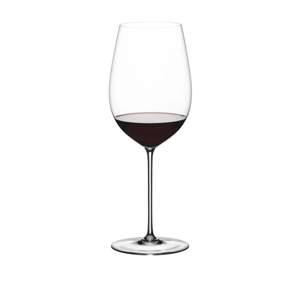
The Bourgogne wine glass is larger and a little more flared, allowing the wine aromas to become more concentrated, and the wine to be aired less. Pinot Noir, the grape varietal used for Burgundy red wines, doesn’t generally need much airing, or else it loses some of its character.
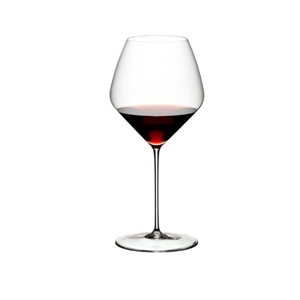
As a general rule for red wines, opt for curved glasses with a slightly closed rim that will help to accentuate the aromas. They will work with most wines and so you won’t need to buy lots of different sets of wine glasses.
• Which glass for your white wine?
Serve your white wine in a smaller glass than your red wine. If your glass is too big, lighter and more easy drinking white wines will lose their intensity. But the glass shouldn’t be too small, or all the aromas won’t be able to be liberated. The main tip is to choose a conical shape, which will intensify the aromas and reveal the colour of the wine. More complex and full bodied white wines, like those from Burgundy, need more space to develop.
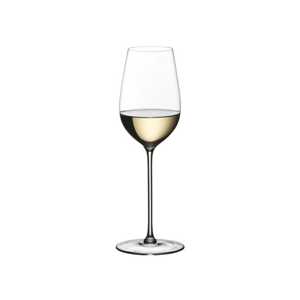
• Which glass for your champagne?
The champagne flute is the most common glass for drinking champagne. It’s thin bowl limits the loss of bubbles.
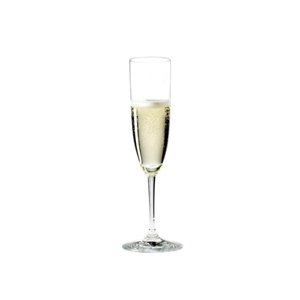
For tasting a very good champagne or one that is very bubbly, it’s best to choose a tulip shaped champagne glass, which will allow you to better appreciate the aromas and subtleties.
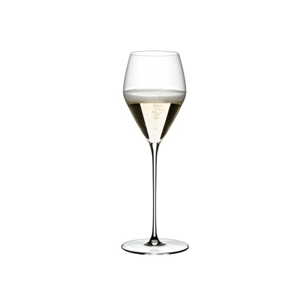
We advise against using a traditional champagne coupe glass, which are flat and wide. Despite their charm, they don’t give the best tasting experience as the bubbles and aromas quickly dissipate due to the shape.
• Which is the best glass for all wines?
The INAO glass is the best glass to use if you had to choose just one! Smaller than a tulip glass, but with the same shape, it is used by wine professionals for tasting sessions. It is perfect for concentrating the aromas quickly due to its smaller size, and the rim that tightens at the top of the glass. You can use it to taste white, rosé, red or sparkling wines with no problem.
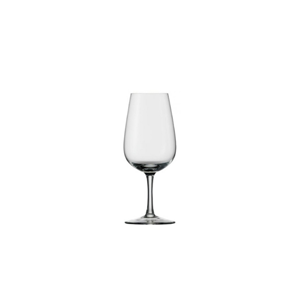
Last tip for choosing your wine glass:
Pay attention to the thickness of the glass, as it will impact the temperature and the taste. A glass that is too thick can quickly warm the wine or cause condensation to form. Thinner glasses also give a nicer feeling on the lips.
What temperature to serve your wine at?
The second factor to take into account when tasting a good bottle is the temperature of the wine. The temperature is very important because it will influence the sensation you feel on your palate, and varies depending on the type of wine.
• At what temperature should you serve red wine?
If a red wine is served too cold, the tannins will lack smoothness. Above 20°C, the taste of the alcohol takes over, and the wine becomes unbalanced.
To truly appreciate a red wine, it’s preferable to serve it a little on the cool side, bringing more lightness to the wine. The right temperature for a red wine is somewhere around 14°C for a light and fresh wine, and 18°C for a more powerful wine.
• At what temperature should you serve white wine?
If a white wine is served too warm, the acidity will be overemphasized on the palate. Inversely, if it’s served too cold, we won’t be able to appreciate all its potential.
For white wines, they shouldn’t be served too cold, never below 8°C, or too warm, never above 13°C, so as to keep the acidity of the wine well balanced.
The livelier and drier the wine, it’s better to serve the wine slightly on the colder side, between 8 and 11°C. For more full bodied white wines, you can serve them between 11 and 13°C. It’s also worth noting that for white wines, it’s better to fill the glass a maximum of a third full and to serve again if needed to keep the wine cooler.
• At what temperature should you serve champagne?
The ideal temperature for serving champagne is between 7 and 8°C. Champagne warms quite quickly in the glass, and so should be drunk between 8 and 10 °C, the ideal temperature for appreciating all of the aromas.
If your champagne is drunk too cold, you won’t be able to detect all of the aromas, and if it’s too warm, the bubbles will seem less lively.
Should you air your wine?
A common misconception is that old wines should be carafed to air them. In fact, this is better advice for young wines, particularly red wines. Young white wines could also benefit from being aired. Airing allows the wines to open up and dissipate unpleasant aromas or tastes.
However, be careful with older vintage wines, as they are more fragile and should be handled with care. They should be tasted first to determine if they need a little airing or not.
To air a wine, you have the choice of opening it several hours before drinking, or to pour the wine into a carafe.
You now know a few more tips on how to get the best out of your wines. Over to you to dazzle your guests!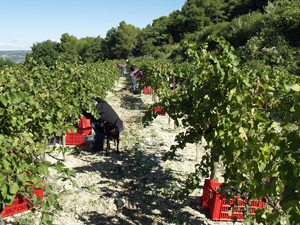
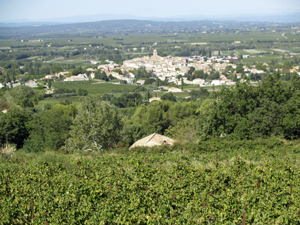
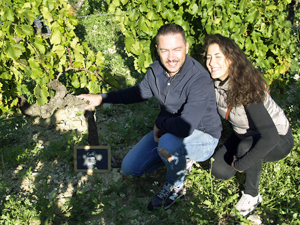
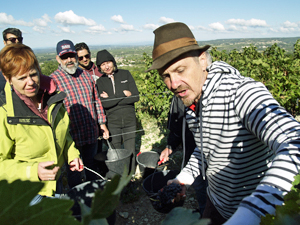
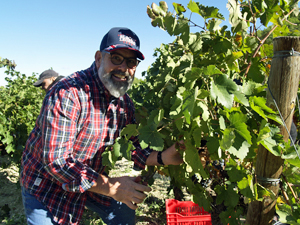
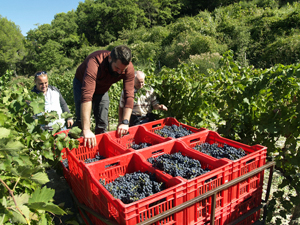
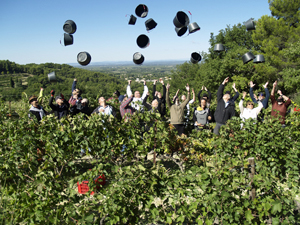
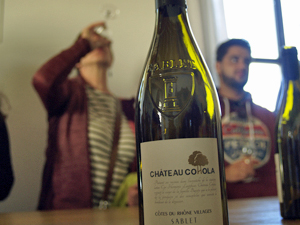
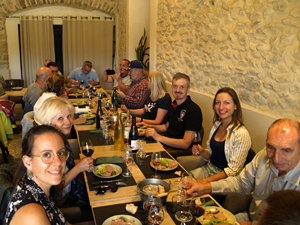
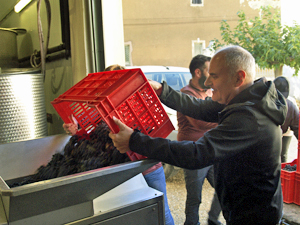
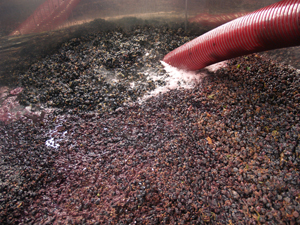
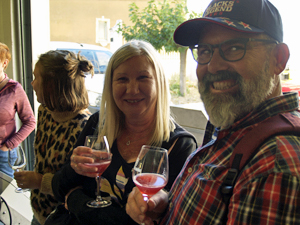
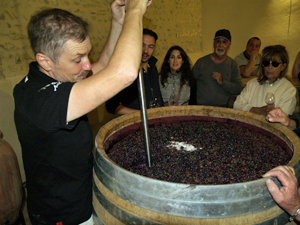
We spent another great couple of Harvest Experience Days in Saint-Emilion at Château Coutet. We were warmly welcomed by Alain and Matthieu, the father and son wine-makers at this family run winery who taught us how to harvest the grapes as we followed their journey during the course of the day from the vines and into the vats. As we were to learn, there is much more to harvesting than just picking grapes!
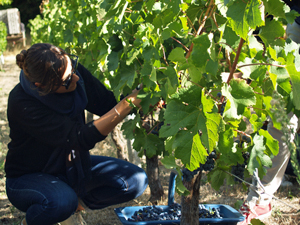
After the introductions, we headed straight out into the vineyard, climbing the hillside to reach the famed Saint-Emilion limestone plateau, where the best plots are located, including the Peycocut vineyard, home to the Gourmet Odyssey adopted vines. We took a few minutes to each find our micro-plot of vines, take a few photos and admire the lovely scenery of sloping vineyards, châteaux and the church spire of Saint-Emilion.
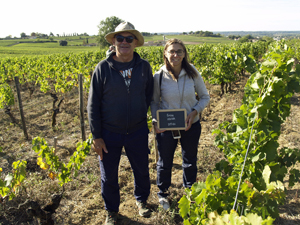
We then made our way to the plot of vines to be harvested. Here we were each given a basket and pair of secateurs and listened to the instructions of which grapes to pick, which ones to leave, and how to cut the bunches safely without cutting our fingers!
In pairs, we spread out among the rows, and started to harvest the grapes! The grapes this year were of excellent quality, so our job was made much easier. There was very little to sort, and virtually all of the grapes were for picking.
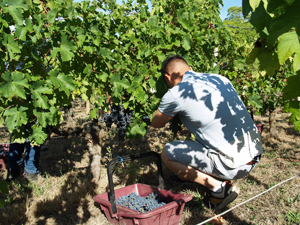
Once our baskets were full, we emptied them into larger crates which were then taken back to the beginning of the row. It’s important not to squash the grapes at this stage, and the crates ensure that they don’t get crushed from the weight of the grapes above them.
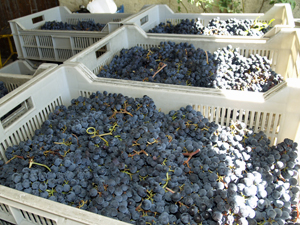
Once we had filled all of the crates, we loaded them onto the trailer to be taken back to the winery and placed in the shade. We followed behind and stopped in the garden in front of the chateau for a well earned glass of wine!
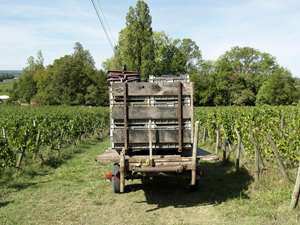
In the afternoon, our mission was to put our harvested grapes into a vat. First we had to separate the grape berries from the stems. This is normally done by a de-stemming machine, but at Château Coutet, the grapes from the best plots are done by hand, including the ones that we had picked. In fours, we gathered around some tables and removed each of the grapes by hand, placing them in a separate basket, and throwing the stems away in a bin. The stems will then be spread in the vineyards to return some nutrients to the soil. It also gave us the opportunity to remove any dried-up grapes or leaves that might have inadvertently made their way into the baskets.
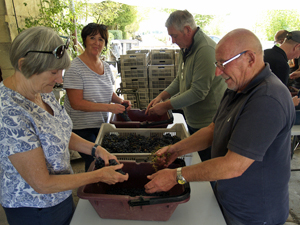
The full baskets of grape berries were then emptied into a large bucket, and we then lightly crushed them using a wooden post to break the skins and release some of the juice. Theses grapes were then emptied into a vat, where they will begin the fermentation process in a couple of days time once the yeast cells naturally present on the grape skins come to life and start to transform the sugar into alcohol.
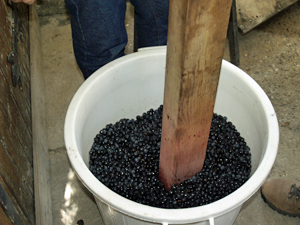
Alain and Matthieu showed us the de-stemming machine and sorting table used for the majority of the grapes at the winery, explaining how they work and how the grapes are then pumped into one of the vats.
We then learnt about the work during the fermentation and maceration phases to monitor the transformation of sugar into alcohol, and to extract the colour and tannins from the grape skins. At Château Coutet the extraction is done mainly by drawing the juice from the bottom of the vat and pumping it back into the top to filter down through the cap of skin and pips that has been pushed to the surface by the carbon dioxide released during fermentation.
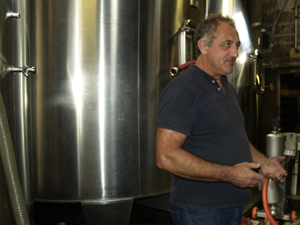
Alain and Matthieu will be kept busy over the next 3 to four weeks tracking and managing each of the vats until the fermentation has finished and the wine is ready to be transferred to the barrels.
We look forward to learning more about this work, and the rest of the wine-making process to age, blend, and prepare the wine for bottling during the Vinification Experience Days next year.
We spent two great Harvest Experience Days on the 3rd and 10th September at Château de Jonquières, a magnificent family-run winery in the Terrasses du Larzac wine-growing region of Languedoc in the south of France. We were there with some clients of the Gourmet Odyssey Wine Experience who had come to get involved in harvesting the grapes and learn about how the grapes are turned into wine during the fermentation and maceration phases.
Charlotte and Clément, the young wine-making couple, are the 32nd generation of winemakers at the winery, welcomed us in the courtyard of the château over coffee. Smiles beamed from each of their faces, which maybe hid a little bit of stress that this crucial period of harvesting in the wine-making year inevitably brings!
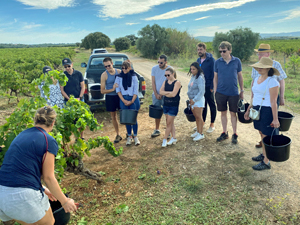
After a quick explanation of the winery’s history, the Terrasses du Larzac wine-growing region, a recap of the 2022 vintage so far, and an overview of the day’s agenda, we were equipped with a bucket and pair of secateurs. We then made our way through the vineyards to a nearby plot of Syrah vines. It’s important to pick the grapes early in the morning to preserve their full potential.
As we walked to the vines, Clément followed by tractor, pulling a trailer into which we would delicately put our harvest.
We were taught how to pick the precious grapes without damaging them or harming ourselves! Sometimes we had to remove some of the leaves in front of the bunches to be able to get to the grapes more easily.
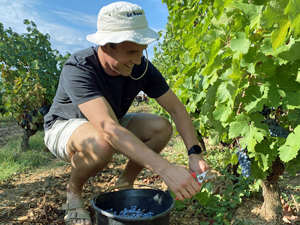
The harvest was generous and of great quality this year despite the very hot spring and summer. The vines were able to adapt to the climate and responded well to the treatment and care of the winemakers throughout the year. Some of our apprentice winemakers had learnt this first-hand during the Discovery Experience Days earlier in the year.
Once the buckets were full, we emptied them into the trailer.
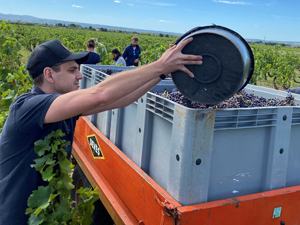
In didn’t take us long to realise that it’s a fairly difficult job. The positions we find ourselves in to pick the grapes can be uncomfortable at times, some rows are more abundant than others, and some harvesters are quicker than others... But the groups remained supportive of one another and we had lots of fun. In just over two hours, we had harvested the plot and had become real harvesters!
We had a quick refreshment break until Charlotte informed us that Clément was already ready to put out harvest into the vat.
We didn’t have any time to lose, and so we brought our precious gaped back to the winery to put them into the vat, but we had one last little job to do before then. We set about cleaning the buckets and secateurs with water so that they were nice and clean for the next day, and once again the team spirit shone through!
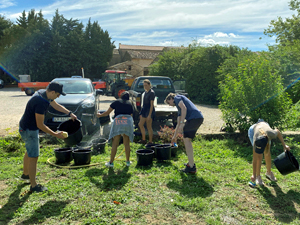
Clément carefully positioned the crates of grapes in front of the chai to then put them into the de-stemming machine.
This is in some ways the first step in making wine, and involves separating the grapes from the stems and any leaves that may have inadvertently fallen into one of the buckets. This avoids the wine from developing a bitter taste.
Once the grapes are freed from their stems, they are put into a stainless steel vat to start the fermentation process.
Charlotte then explained the differences in the process for white, red and rosé wines. For example, the red wines are kept in contact with the skins during the fermentation and maceration phase which lasts around 20 days, whereas the white grapes are immediately pressed before the fermentation phase starts to separate them from their skins.
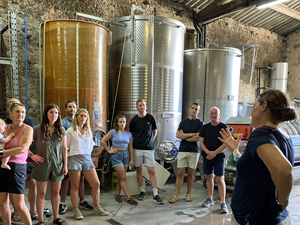
We tasted some of the grape musts that had been fermenting for 10 days, and Charlotte suggested that we put our ears to the vats to listen to the effervescence of the fermentation.
It was then time for lunch, and so we made our way back into the shade of the courtyard to taste 5 of the winery’s organic wines over lunch which had been prepared by a local caterer. We took the opportunity to ask the winemakers lots of questions about a wide range of topics such as their way of life, their philosophy of being organic, and the differences between the wine that we had tasted.
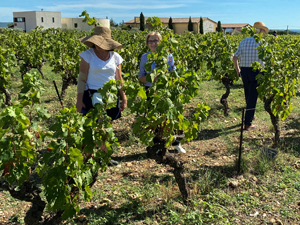
After lunch, we went to visit our adopted vines. After a short walk through the village of Jonquières, we arrived at the vineyard where our vines are located, and spent a few minutes metting our vines, and taking some photos of them.
We then returned to the chateau to bring the day to a conclusion, and collect a few bottles of wine to take home with us and share with friends and family.
We look forward to welcoming you back to the winery next year for one of the Vinification Experience Days!
We welcomed our apprentice wine-makers to Domaine Chapelle in the Burgundy village of Santenay for the Harvest Experience Days on the 27th, 28th, and 29th August. 2022 is a very early year due to the high temperatures of the last few months. Our objective for the days was to pick the grapes, follow their journey into the vat, and to learn about all the work in the cellar during harvest time. There’s more to harvesting than just picking grapes!
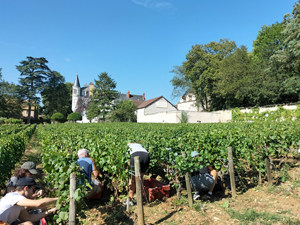
After an introduction to the day and the Gourmet Odyssey Wine Experience, and of Domaine Chapelle’s history, we walked to the “Clos des Cornières” and “Les Crays” vineyards, where the adopted pinot noir and chardonnay vines are to be found.
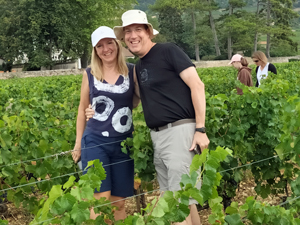
We took a few minutes to say hello to our adopted vines, and take some photos for the “My Vine” photo competition. A magnum of Santenay wine is up for grabs!
After this fun start, it was time to get down to the more serious business of harvesting, and so we gathered in the Clos des Cornières vineyard where the beautiful bunches of grapes from this exceptional vintage were waiting.
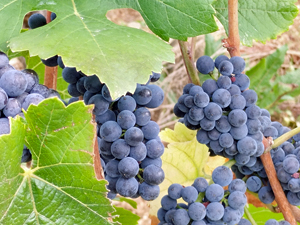
Climate-wise, the last couple of years have been challenging, and so we were delighted that the 2022 vintage had produced such good quality grapes, and of a normal quantity!
Jean-François and Simon gave us each a pair of secateurs and explained how to pick the grapes, which ones to harvest and which to leave on the vine. The ripe grapes are located at the bottom of the vine and, as we quickly noticed, the vines in Burgundy are very low to the ground!
In pairs, we each took a row and started the harvest. First we removed the leaves around the grapes to see them better. This makes it much easier to cut the bunches without taking our fingers with them!
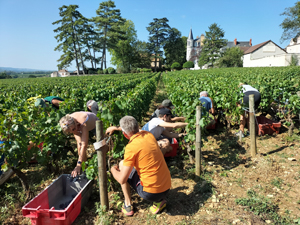
We put the cut grapes into crates, which is the best way to harvest pinot noir due to their delicate skin. The crates avoid the grapes being squashed by the weight of other grapes above them, ensuring that they arrive in the cellar in the best possible condition.
Harvesting is a physically demanding job as our backs and legs could testify! But it’s also very rewarding and satisfying to see the rates full of delicious grapes! And to arrive at the end of the row!
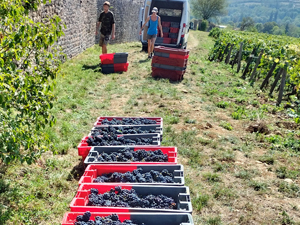
Once the crates were full, we brought them back to the beginning of the row to be taken back to the winery in the van.
After the effort, our reward was a lovely glass of chilled 2020 Santenay Villages white wine which we enjoyed in the garden, accompanied by the famous Burgundy gougères.
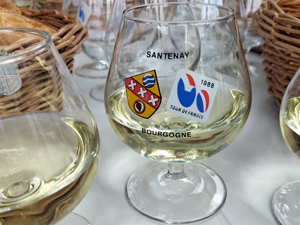
We then sat down to enjoy lunch. Poached egg on a bed of mushrooms, veal risotto and potatoes, and a framboisier to finish. The courses were accompanied by a Burgundy Aligoté, a 2019 Santenay Clos des Cornières, and a 2016 Santenay Les Gravières Premier Cru. All delicious!
In the afternoon, we made our way to the sorting table to participate in the process involved in putting the grapes into the vat.
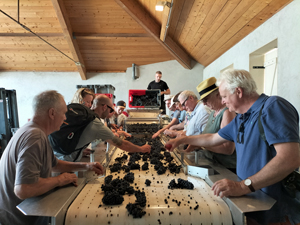
We learnt how the work is organised around the sorting table and we got involved. The quality was so good this year that we didn’t have a very stressful job! We did however have to remove some of the grapes that had been scorched and had dried out due to the drought, but fortunately there weren’t very many.
We then went down into the fermentation hall, one floor below. The grapes that had been separated from their stalks by the de-stemming machine fall into a trolley using the power of gravity. Once the trolley is full, it is pushed next to the vat to be filled, and the grapes poured into a vertical conveyor belt, known as the giraffe, which carries the grapes up into the vat without the need for a pump.
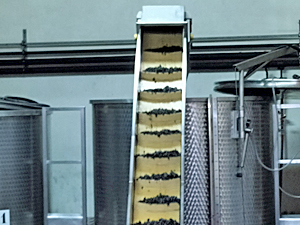
This method of putting the grapes into the vat treats the grapes very gently, keeping each individual berry as intact as possible to start the maceration phase before fermentation starts.
For three days, the harvested grapes are kept cold during the initial maceration stage, and then the temperature is warmed to allow the fermentation to begin. This will last for approximately 10 days. At the same time, the maceration continues and the tannins and colours are extracted by pigeage and pumping over. The maceration phase lasts for around three weeks.
Then comes the time to separate the wine from the solid matter, and to put the wine in the oak barrels to start the ageing process which will last for around one year. We’ll learn more about the rest of the work in the cellar after the harvest and up until bottling during the Vinification Experience Days in spring next year.
And so the day drew to a close and having collected some bottles of wine for the most part, we parted company, promising to come back soon to discover more of the Burgundy terroir in Santenay!
The key steps involved in wine tasting
- Categories :
- Gifts
- Wine
- Wine News
- Wine Making
- Enjoying Wine
- Gourmet Odyssey
Step 1 : The look
The first step is to place your glass of wine above a clear white surface, ideally in the light. You’ll be able to judge how clear it is based on the number of particles that are held in suspension, and gauge its level of acidity. If you can see thick tears form on the inside of the glass, it’s a sign that the wine is full-bodied, and inversely if the tears are finer and flow more quickly, the wine is likely to be more acidic.
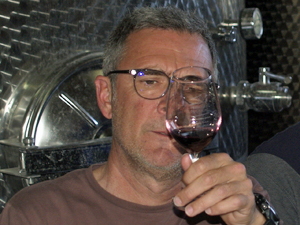
You can also pick up some clues regarding the wine’s age to indicate whether the wine is likely to be young or old. For red wines, the colour changes from bright red or purple for the youngest wines to a rusty colour for the older ones. And for the white wines, from pale yellow or even green to a deep amber colour.
Step 2 : The nose
This phase is done in two parts. Without moving the glass, place your nose over the glass and take in a big sniff. This is known as the first nose. Then swill the wine carefully around the glass a few times to oxygenate the wine and liberate the less volatile aromas before sniffing again. This is known as the second nose. Often, there is a big difference between the first and second noses.
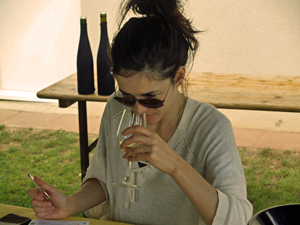
There are different types of aromas; primary, secondary, and tertiary aromas. The primary aromas come from the grapes themselves, and there are a wide range of smells such as floral ones (acacia, honeysuckle, jasmin, rose, lilac etc.), fruity aromas (pineapple, apple, lemon, mango, peach, apricot, raspberry, blackcurrant, blueberry, etc.), vegetal aromas (aniseed, thyme, grass, pepper, fennel etc.), or spicy aromas (cinnamon, pepper, nutmeg, etc.)
The secondary aromas come from the fermentation, and we can find three distinct types. There are those that are produced by the fermentation process such as brioche, yeast or biscuit. There are also the milky aromas such as butter, yoghurt or milk, and the alcoholic aromas such as boiled sweets, nail polish, or banana.
The tertiary aromas develop during the ageing process, several months after the harvest. Oak barrels give woody aromas such as cedar, oak, vanilla, and eucalyptus, spicy aromas such as pepper, cinnamon, and liquorice, or toasted aromas such as toast, coffee, grilled almonds, or tabaco.
Step 3 : The taste
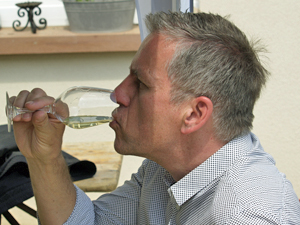
When finally getting to the tasting stage, take a small amount of wine in the mouth, breath in a little air between the lips, swill the wine around the mouth, then breath out of the nose to let the taste and aromas to develop, before swallowing the wine or spitting it out.
There are three moments to take note of:
- The attack. What impression does the wine give the moment you take it into your mouth? It can be weak, strong, or intense.
- The mid-palate. Analyse the texture of the wine and the aromas. Is it smooth, acidic, are there any new aromas that have developed since step 2?
- The finish. Once you’ve swallowed the wine, what sensation prevails, and how long does the taste last? If there are lots of tannins present it will have a longer finish, and a wine that is fruitier is likely to have a shorter finish.
Using our senses is very important in tasting wine, and by following these stages, you will be able to comment on a wine more easily, and to compare it with others. Wine-tasting skills improve with practice and remembering the characteristics of the wines that you have previously tasted. You can always use a notebook to write down your thoughts. And remember the two most important things when tasting wine. It starts with “I like the wine, or I don’t”. And secondly, we all have our own perceptions of smell and taste, and so it is remains very subjective!
To develop your wine tasting skills further, you can participate in a Vinification Experience Day and learn directly from the winemaker and a Gourmet Odyssey wine expert. Each of the partner wineries are organically certified, and the wine-making course teaches you about all that happens in the cellar from the harvest, right up until the moment when the wine is ready for drinking During the day, you’ll see how the fermentation phases change the structure of the wine, participate in a wine-tasting workshop to help you develop your senses, taste wines that are in the ageing process, and get involved in blending different wines.
We kick off with a great classic. A butterfly shoulder of lamb, accompanied by the fruity and intense Côte du Rhône Villages Sablet red from Château Cohola.

The Terrasses du Larzac “Lansade” red from Château de Jonquières pairs perfectly with a smoked duck salad. Freshness on the palate with a nice long finish.

The colourful asian sautéed noodles with ginger, served with a fruity, aromatic Pinot Gris Rosenberg white wine from Domaine Stentz-Buecher in Alsace for your lighter dishes when it gets hot.

Wild sea bass or swordfish accompanied by a dry white wine next to the sea like the Santenay Village from Domaine Chapelle. This rich Burgundy wine will reveal its fresh side thanks to the saltiness of the fish.

A spatch-cooked chicken on the barbecue is perfect with the Santenay “Clos des Cornières” red, our 100% pinot noir from Domaine Chapelle. It’s a nice strong Burgundy with notes of liquorice that goes very well with a tarragon marinade.

Cold roast beef with home-made chutney is a fine match for our Clos de la Bonnelière red wine from Château de la Bonnelière. This refined Chinon wine mixes power and purity to give added elegance to your summer picnic.

And to finish in beauty, what better for the gourmands than a grilled côtes de bœuf served with glass of Château Coutet Saint-Emilion Grand Cru. The fruitiness and light touch of spice of this fantastic Bordeaux will bring out the best in the beef.

Just a few ideas of some great meals and wine to share or treat yourself to this summer!
Don’t forget to tag us on the social media and immortalise your food pairings with the wines of Gourmet Odyssey’s organic partners with the tag #SUMMERWITHGOURMETODYSSEY.
All the Gourmet Odyssey team wish you a great summer!
Get involved in making your own personalised bottles of wine with the Gourmet Odyssey Wine Experience.
In May and June we welcomed some of our adopt-a-vine customers to Château de la Bonnelière in the Loire Valley to discover the work of the wine-maker in the vineyard. These hands-on wine experience days enable us to spend the day with the wine-maker and get involved in the seasonal work. As we were to learn, it’s a very busy time of year in the vineyard, and so our help was very welcome!
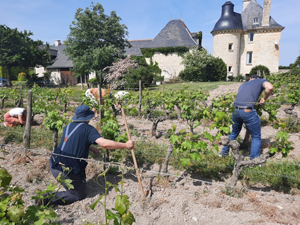
Each of our days start with a short time for all of the participants and the wine-maker to get to know each other over a coffee and croissant, and to talk about our favourite subject – wine!
Once all of the participants had arrived, it was time to get down to more serious matters, starting with the programme of the day and the activities that we could look forward to. At this stage of the vine’s lifecycle, we’re in the “green work” phase, and Marc was very pleased to have a few extra pairs of hands!
Before getting started, we headed out into the Clos de la Bonnelière vineyard where our adopted Cabernet Franc vines are located. Cabernet Franc is THE grape varietal for Chinon red wines. We checked that the vines were well, and that they hadn’t suffered from the frost or the more recent hail storm. Fortunately the vineyards at Château de la Bonnelière escaped the storm which proved to be so severe for some of the nearby wineries.
After the photo shoot for the “My Vine” photo competition, Marc explained the work that had been carried out in the vineyard so far, and the work to be done. It was then time for us to get stuck in.
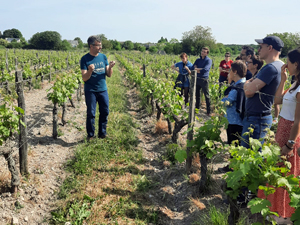
For the Discovery Experience Day in May, we removed the shoots that had sprouted from the vine trunks. These young shoots take away energy from the vine, and won’t produce any grapes, so it’s best to remove them to improve the quality of the grapes on the fruit-bearing branches. Our hands, a spade and sickle were the tools for the job!
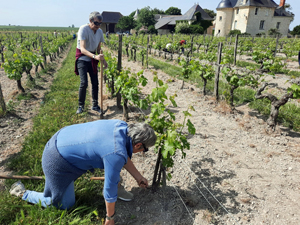
In June, the foliage had grown much more thanks to the warm and sunny days. We then moved onto the next job to be done which was to remove some of the leaves from around the grapes. This ensures that the grapes receive more sun and a better air flow around them to dry them after any rainfall. Marc removes the leaves only from the side that is facing the rising sun, as it is softer in the mornings, whereas in the afternoons the grapes need some shade from the stronger sun to avoid being burnt.
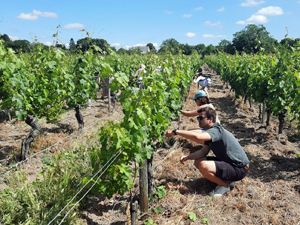
These two jobs kept our participants busy until it was time for the welcome aperitif, enjoyed in the shade of the château’s walls in the inner courtyard. We learnt more about the winery, the château, and of course the wines that we continued to taste and enjoy throughout lunch. Marc explained his philosophy for making wines, and how he tries to capture the expression that each of his different vineyard plots gives to his wines.
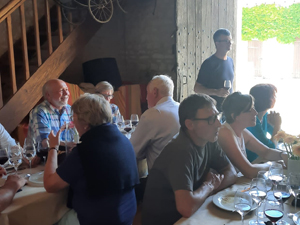
After the delicious lunch and with the warm sunshine, it was difficult to get up from the table, but the stroll in the vineyard was good for our digestion! We visited a plot of young Sauvignon Blanc vines that had been planted last year to replace the existing plot that had suffered badly from a wood disease. The young vines are developing well, and will start to be pruned and harvested next year.
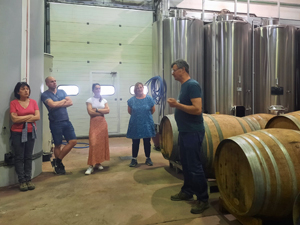
The end of the day approached, and so we went to the fermentation hall for a quick overview of what happens to the grapes once they are harvested.
We look forward to welcoming you back for the Harvest Experience Days in September or October, and the Vinification Experience Days next year!
We enjoyed hosting the Vinification Experience Days at Château de la Bonnelière in the charming Loire Valley town of Chinon. It’s the last of three types of day proposed in the Gourmet Odyssey Wine Experience, the theme being to discover the work of the wine-maker in the cellar to make, age and prepare the wines for bottling.
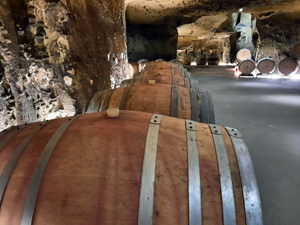
The days started at the entrance to the winery’s cellar, located in the centre of Chinon, directly beneath the fortress. It’s a breathtaking place, and we enjoyed a coffee and croissant outside in the warm sunshine.
Marc explained his family’s history and that of the winery, and then talked to us about the Chinon wine appellation and the vintage that is currently ageing in the cellar, bringing us all up to speed, ready to start the day! The aim was to understand all that happens after the harvest, and the choices that the wine-maker takes to shape the taste, structure and aroma of the wine.
The cellar is used to age the wines in the barrels until they are ready for bottling and drinking. Marc uses French oak barrels between 400l and 600l, which are larger than standard barrels so that the wine isn’t as marked by the wood.
The wines are made according to the vineyard plot and type of soil. In Chinon, there are three principal soil types: sand, clay limestone, and flint. Each type of soil gives a different style of wine, and so Marc adapts the choices he makes accordingly. The wines from the sandy soil are aged in vats, the majority of the clay limestone wines are aged in oak barrels for 12 months, and the flint wines are aged in oak barrels for between 24 and 30 months.
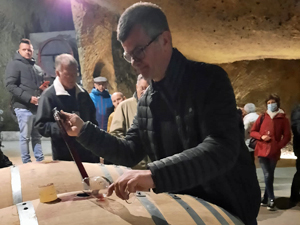
We had the privilege of tasting some of the wines that are still undergoing the ageing process, which is something that is very rare to do. As the wines weren’t yet finished, they held a few surprises for us!
It had been a full morning, and Louise added a few additional explanations on the history of the cellar and the Chinon Fortress. We then made our way to Château de la Bonnelière, where Claudine, Marc’s wife, and the sun were waiting for us, along with a nice fresh glass of sparkling wine, in the château’s courtyard.
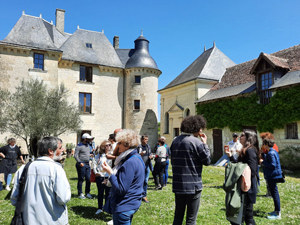
We then sat down to lunch in the barn, and revelled in the different courses and locally produced asparagus, goat’s cheese and strawberries, accompanied by Marc’s delicious wines.
Difficult afterwards to get up from the table, and as much as some of us would have liked to settle down to a nice siesta, we headed out to meet our adopted vines in the Clos de la Bonnelière vineyard. This is the historical plot of the winery and was planted in the 1980’s by Marc’s dad.
The fermentation hall was the next stop to see where the grapes are received at harvest time, and how they are transformed into wine during the fermentation and maceration stages.
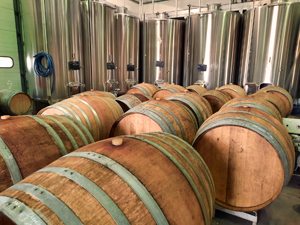
Marc explained his secrets for making good wine : Time, care, and love of what you are doing...
The day finished with a visit of the room used to bottle and label the wines, bringing to a close a great time spent exchanging knowledge, ideas, laughs and opinions. We love spending these moments with you, and look forward to seeing you again in Chinon or at another of our partner wineries soon.
We spent a fantastic Vinification Experience Day in Saint-Emilion at Château Coutet. This hands-on wine course is the last of the days that Gourmet Odyssey offer and is focused on the work in the cellar to ferment, age, blend and bottle the wines.
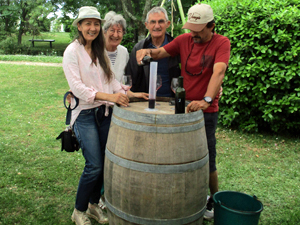
Our hosts for the day were Benoît, the Gourmet Odyssey wine expert, and Alain, the winemaker and owner at Château Coutet. We shared a coffee and croissant to get to know each other, whilst Benoît explained the order of the day. Alain then started to recount the family’s relationship with the winery. It’s a magical place and full of history as Alain represents the 13th generation of winemaker there from his family. The tradition is set to continue as his son and nephew joined him a few years ago.
We were then led into the fermentation hall to pick up where we left off during the Harvest Experience Day. We learnt about the work during the fermentation and maceration phases, Alain replying to the many questions that arose. We then went through to the barrel room where the 2021 vintage is currently in the ageing process. Alain explained how he monitors the wines, and keeps the barrels topped up to replace the angle’s share that is lost to evaporation.
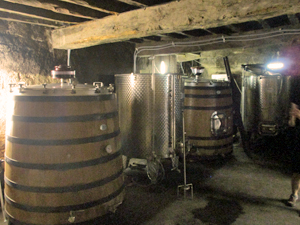
To better understand the role of a winemaker, Benoît had organised a wine tasting session for us. He taught us the basic principles to ensure that we had a common language to describe the wines, and then we set about tasting several different series of wines. We honed our senses and gained in confidence to describe the sensations that we were experiencing.
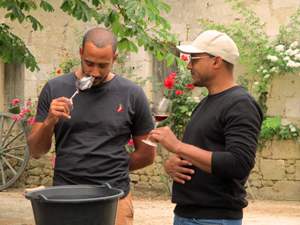
We finished the morning with a wine blending workshop to better appreciate the characteristics that each grape varietal brings to a wine. We then had a go at making our own blends and tasted our different wines!
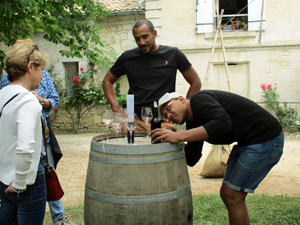
Our taste buds were fully awake for the tasting of the winery’s finished wines, and we started with the Claret de Coutet, a wine that is mid-way between a red and rosé, and refreshed our palate after tasting all those red wines that are still in the ageing process.
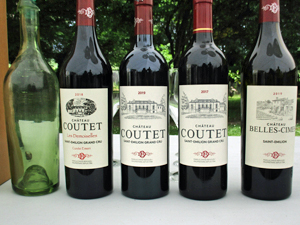
We then sat down to lunch, where Benoît served us a glass of the 2019 Château Belles-Cimes with the Landaise salad. It’s the second wine, made using the grapes from the young vines. It’s not made every year and is a wine that can be drunk a little earlier than the winery’s first wine. We tasted the 2017 and 2019 vintages of the Château Coutet wine with the magret de canard main course. It was very interesting to compare the two vintages and see the difference that two extra years ageing in the bottle brings. We finished lunch with the 2018 Demoiselles wine, which is a blend of two different plots on the limestone plateau that are worked by hand and with the help of a horse. The meticulous work, combined with the great terroir, gives a magnificently deep wine.
In the afternoon, we returned to the vineyard to visit our adopted vines that are located in one of the winery’s lest plots up on the limestone plateau, just a few hundred metres from the bell tower in Saint-Emilion. It’s a fantastic place, and we each took a few minutes to immortalise the moment and take some photographs.
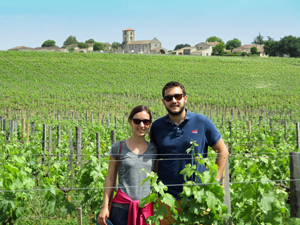
We finished the day in the storage cellar, where Alain explained the last steps involved before the wine is ready to leave to the winery, covering the bottling and labelling processes.
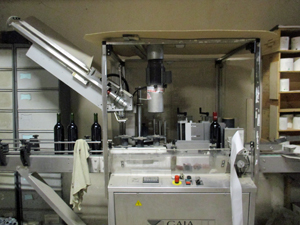
Many thanks to Alain for his warm welcome and for having given us such a deep and frank insight into his job as a winemaker.
We met up at Château Coutet in Saint-Emilion for a Gourmet Odyssey Discovery Experience Day. The aim of the day was to learn about the winemaker’s work in the vineyard to produce the best possible grapes.
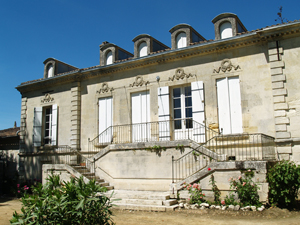
Alain, the owner and winemaker, welcomed us with a coffee and some pastries. Alain is the 13th generation of winemaker at Château Coutet, his family’s history there starting some 400 years ago. He is now proud to work alongside his son and nephew who have joined him in running the winery.
We started with a walk through the different terroir that make up the winery to better understand this prestigious Bordeaux wine, and the different grape varietals that are grown on the estate.
At the top of the hill that looks down over the Dordogne Valley, we stopped to take in the magnificent view and then learnt about the winemaker’s work in the vineyard during winter to prune the vines. It’s a fascinating job, but also very complex as we were to learn.
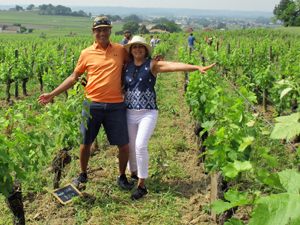
The plot of Gourmet Odyssey adopted vines was located nearby, on Saint-Emilion’s limestone plateau, rubbing shoulders with some of the most prestigious names. We each found our micro-plot of vines, thanks to a slate nameplate that had been placed in front of them. We all took some photos of this magnificent setting, and some came up with original ideas for the “My Vine” photo competition organised by Gourmet Odyssey in the hope of winning a magnum of wine!
It was now time to get down to some work. The task of the day was to raise the training wires, trapping the branches between them in the process. This ensures that the tractor can continue to pass freely through the vineyard to treat the vines and protect them from mildew and odium. It’s quite an easy job, but the intense heat made us aware of how the weather can have a big impact on the winemaker’s work.
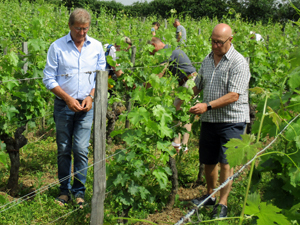
The Claret de Coutet wine was welcome refreshment back at the winery after our efforts in the vineyard. We then sat down to lunch and continued to taste different wines. The winery’s second wine, the 2019 Château Belles-Cimes gave us an introduction into the more classic Saint-Emilion red wines. It’s made using the young vines and is less fruity and less tannic than the longer 2019 Château Coutet that we tasted afterwards. We ended the tasting with the magnificent 2018 Demoiselles that is a truly great wine that will further improve with age.
After the delicious lunch, we regrouped in the shade of the old oak tree to listen to Alain talk about the benefits and challenges of cultivating the vines organically. He also explained the work still to do in the vineyard before the harvest, at which time we will return for the Harvest Experience Days.
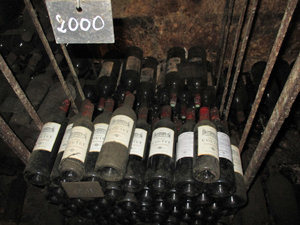
We ended the day with a visit of the cellar which is one of the more rustic ones to be found in Saint-Emilion, and a tour of the family cellar that stores the old vintage bottles from the winery, the oldest of which dates back to 1945!
Many thanks to Alain for his good humour and his explanations of the vineyard, family, and his daily life of being a winemaker.
Chéli and Jérôme, the passionate winemakers at Château Cohola, welcomed us warmly to their organic winery for a Discovery Experience Day. The aim of this wine experience day was to learn about the work required in the vineyard to nurture the vines and produce the best quality grapes possible.
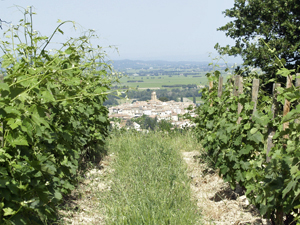
Perched in the foothills of the Dentelles de Montmirail ridge, the winery has a stunning view over to the village of Sablet and the plain of Côtes du Rhône vineyards that stretch below. This was our backdrop for the introductions to the day by Mark, the founder of Gourmet Odyssey, and Chéli and Jérôme from Château Cohola.
We then headed out into the vineyards, pausing on the way for Jérôme to explain the work done in the vineyards during the winter months, notably the different pruning methods used for different grape varietals, and the organic methods used to nurture and protect the vines.
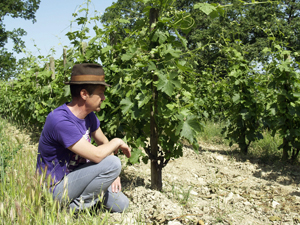
At this time of year, the vines grow rapidly, and it’s a very busy period to try and keep everything in order, and so the help of our winemakers-for-a-day was very much appreciated! As always with a Gourmet Odyssey Wine Experience Day, we had some work to do to attach the staked vines, or “échalas” vines.
The vineyards at Château Cohola are spread among 15 terraces, some of which are fairly small and unpractical for tractors and heavy machinery to access. In such places the échalas system is used to provide support to the vines that would normally be done by training wires. A wooden stake is positioned next to each vine that has been pruned using the goblet method, and once the branches have grown to around a metre in length they are bunched together and tied around the stake using a piece of raffia. This will help the vine support the weight of the grapes to come and reduces the risk of branches being damaged by wind, something that is often present in the Rhone Valley.
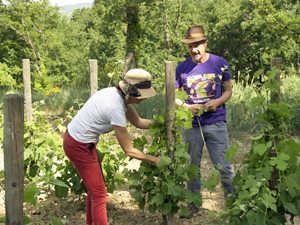
Chéli and Jérôme demonstrated how to attach the vines, and then in pairs we spread out in the vineyard to have a go ourselves. Standing on opposite sides of the vine, we collected together all of the vine branches. One person hugged the vine to keep them all together, whilst the other tied a piece of raffia around the stake and branches to keep them in place.
It took us a few vines to get the hang of it, but we were soon experts, and we became much quicker. It’s also a very rewarding task, as you can instantly see the result of your work. When we arrived in the vineyard, the branches were falling in all directions, but at the end everything was very orderly, and we could walk easily around the vines. This also has the benefit of lifting the branches off the ground and from becoming entwined with the surrounding vines which would increase the risk of disease spreading.
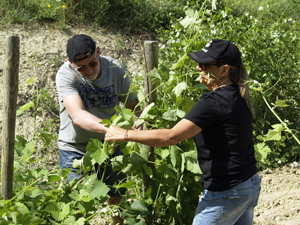
Jérôme then guided us up the hill, explaining the different plants along the way, until we arrived at another stunning viewpoint looking over the Rhone Valley below. Here we enjoyed an aperitif of the Château Cohola rosé wine, with some local olives and cheese.
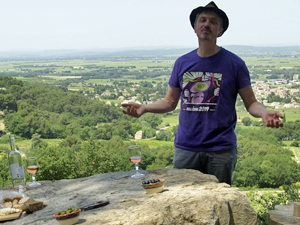
Back at the winery, we sat down to lunch in the shade of the platane trees. With the deliciously fresh crespou starter we enjoyed the Château Cohola Cuvée Fruit red wine. To accompany the filet mignon and ratatouille main course, we tasted the 2018 vintage of the Château Cohola Sablet, the red wine that is chosen for the Gourmet Odyssey Wine Experience. The local goat’s cheese was served with the delicious honey made from the winery’s own beehives and the 2021 Château Cohola Sablet white wine. Lunch ended with a strawberry tart and two more wines. First the Château Cohola TBF red wine, which is made using wine aged in a clay amphorae and oak and stainless-steel barrels, followed by the powerful and full-bodied Cor Hominis Laetificat Châteauneuf-du-Pape.
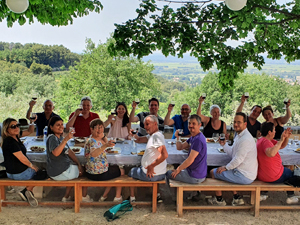
After lunch, we visited our adopted vines that will produce the grenache grapes used to make the wine that we will receive at the end of the experience.
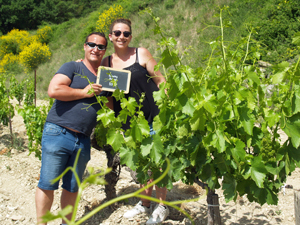
Jérôme then explained the work that remains to be done between now and the harvest before we headed down into the village of Sablet for a quick tour of the chai.
Chéli and Jérôme showed us the press used to extract the juice from the grapes for the white and rosé wines, and the vats where the grape juice will ferment, and then the barrel room where the wines are aged. We’ll be spending more time here during the Harvest and Vinification Experience Days.
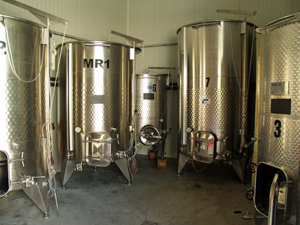
Many thanks to all for a fantastic day! We’ll think a little differently and will appreciate the work that goes into making wine a bit more when we open that next bottle of wine!
We were blessed with a lovely summer day to welcome the apprentice winemakers to Domaine Chapelle in the picturesque Burgundy village of Santenay. This hands-on wine-making experience day is designed so that wine lovers can learn more about all of the work in the vineyard needed to produce the best quality grapes.
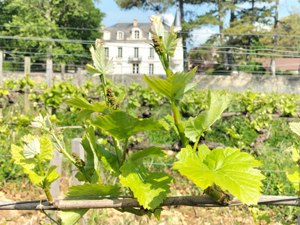
In the château’s garden, overlooking the vines, Jean-François explained the history of his family, the winery and the development of Burgundy wines. The terroir, the grape varietals, and the winemakers are the major influences on the quality of wine, something that was important to Jean-François to emphasise as an introduction to the day.
We made our way down into the vineyard to start the day by meeting our adopted vines, and giving them some gentle words of encouragement in producing a good harvest this year! There were lots of photos taken, some of them very original for the “My Vine” photo competition.
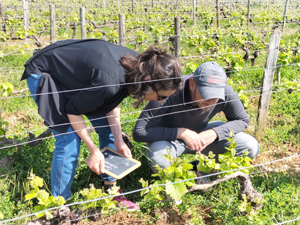
Simon, the son of Jean-François, is now in charge of the production side of things at the winery, and he explained the work that is carried out in the vineyard throughout the year’s cycle, including working the soil, and the treatments used in organic winemaking.
The main work in the vineyard at the moment is de-budding, which involves removing some of the unwanted shoots to stop the vines from producing too many grapes and from wasting energy on non fruit-bearing branches. It also helps to improve the airflow around the vines and grapes which will help reduce the risk of mildew setting in. A good air flow is very important in organic farming to dry the leaves and grapes as soon as possible.
There are a few important details to take into consideration. First we need to identify which branches are well placed to act as the spur during pruning and so produce the branches for next year. We also need to be sure not to damage the fruit-bearing branches that we wish to keep for this year, and to clean the old wooden branches by brushing them to remove any potential buds that might yet sprout into life.
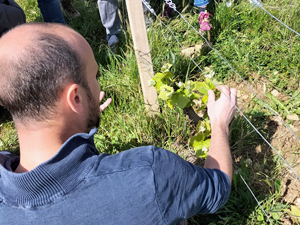
It’s a delicate job that demands a skilled eye, and is something that needs to be achieved in 3 weeks throughout all of the winery’s vineyards, before the branches become too thick to be easily removed. That’s why the winery hires an extra 10 seasonal workers during this period to bolster the team of permanent staff.
The help of our apprentice winemakers was therefore very much appreciated! We each had a go, and despite our worries of not doing a good job, we soon gained confidence!
After our effort, we reconvened back at the winery for a nice fresh glass of Santenay white wine, accompanied by some gougères. We then sat down to a delicious lunch which had been prepared by a local caterer from Meursault. We tasted three other wines from Domaine Chapelle, a Burgundy white, a Santenay Clos des Cornières red, and a Santenay Premier Cru Les Gravières.
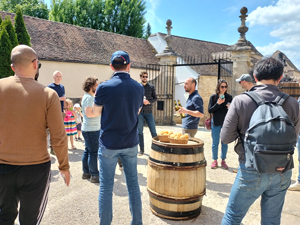
We started the afternoon with a walk through the vineyards to have a look at a plot that had recently been replanted. Simon showed us the surrounding landscape and explained how the different terroir determines the quality of the wine. He then shared with us how to plant new vines and the consequences of doing so.
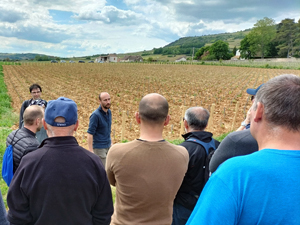
The old vines had been pulled out, and the vineyard plot left fallow for 3 years to regenerate the soil. The new vines were planted in 2021 just before a severe frost, and around 20% of the vines perished as a result, so the winery has had to replace the dead ones. For a further three years the vines will concentrate on developing their root system, and there will be no harvest, so the winery will have to wait around 7 years before the whole plot is productive again. The cost of replanting a vineyard is substantial for the winemaker, but is necessary to successfully transfer the winery on to the following generations.
After, this very interesting discussion in the vineyard, we returned for a quick tour of the cellar, which gave us a good introduction to the Vinification Experience Day for those that will be coming back or want to add the day.
It was a great day and we loved sharing it with you. We hope to see you again soon at Domaine Chapelle or another of our partner wineries!
To make a great wine, you need to make sure that you produce the best possible grapes, and that involves lots of hard work and dedication in the vineyard throughout the year. We spent a very enjoyable and informative day at Domaine Stentz-Buecher in Alsace to learn about the different tasks involved, and by the end of the Gourmet Odyssey Discovery Experience Day we left with a much deeper appreciation of just how much there is to do to make organic wine.
After the introductions to the day, we headed out into the vineyard with Céline and Stéphane, the brother and sister duo who run the winery. Our first stop was to visit the Rosenberg vineyard where our adopted vines are located. We took a few minutes to find our vines, give them some words of encouragement and to take a few photographs.
Stéphane then led us to a plot a little further along the track and explained the work that has already been carried out in the vineyard during the winter months to prune the vines and work the soil. Pruning is one of the most essential jobs, as it helps the winemaker to control how many grapes each vine can potentially produce. By reducing the quantity, you can increase the quality of the grapes and thus the wine that they will make.
Stéphane explained how the branches left on the vine were then bent and attached to the training wire to slow the flow of sap and help the vines to produce more uniformly ripe grapes.
The buds had already appeared, and the shoots had started to grow from each of the nodes. Each shoot will grow to form the fruit bearing branches for this year. We could even see the first signs of the grapes to come.
As always during a Gourmet Odyssey Experience Day, Stephane had left us some work to do. Despite their endeavours during pruning, there are always some extra unwanted shoots that appear, whether from a double bud, or from lower down on the vine trunk. The vines that Stéphane had brought us to were fairly young and vigorous, so they had lots of shoots that had sprouted on the trunks. If left, they will take energy away from the vines and have a negative impact on the quality of the grapes, so our job was to remove them. A simple job by hand when they have just appeared, so it’s important to do so before the shoots grow too much and become thicker.
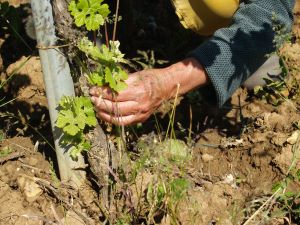
We then returned to the winery, where Céline had prepared a tasting of some of the different wines that the winery produces, starting with the 2019 Muscat wine from the Rosenberg vineyard. We then tasted the citrus and aromatic 2018 Riesling Ortel, followed by the 2019 vintage of the Pinot Gris Rosenberg that is the wine chosen for the Gourmet Odyssey Wine Experience.
The tasting continued over lunch of a delicious baeckeoffe, local cheeses, and blueberry tart, which were paired with the 2018 Who Am I?, a blend of Pinot blanc, Pinot Gris and Riesling, the 2020 Pinot Noir Tradition, and the 2019 Gewurztraminer Rosenberg.
After lunch Stéphane explained the work that is left to do in the vineyard between now and the harvest, and how to know when the right time is to pick the grapes. We also talked about working organically and the importance of respecting the surrounding environment.

We ended the day with a tour of the cellar. Stéphane showed us where the grapes will be received during the harvest and gave us an overview of the fermentation and ageing process. We’ll learn more about these two stages during the Harvest and Vinification Experience Days.




